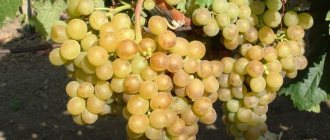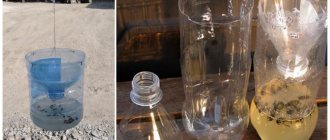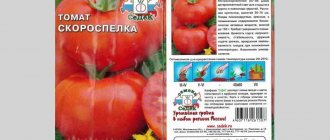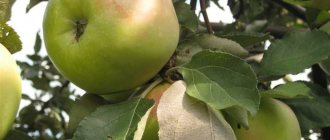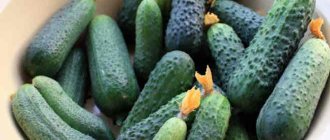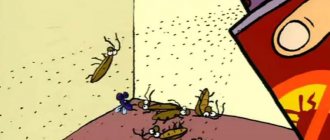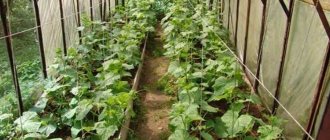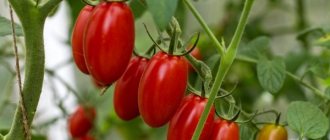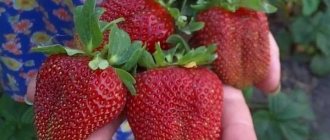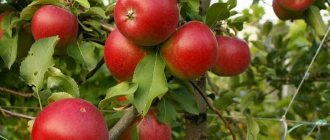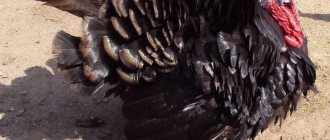Grapes from your own garden are tasty and healthy. You can grow delicious berries not only in the south, if you choose the right variety. Early ripening, aromatic Laura grapes, a description of the variety, reviews and photos of which are presented below, were developed by Ukrainian scientists. It is successfully cultivated in Ukrainian grape farms and in a number of regions of Russia, Moldova, and Belarus. A distinctive feature of the variety is excellent yield and preservation of berries. Laura is suitable for home and commercial cultivation.
Important! You won’t be able to find a variety called Laura in the state plant register. This name is more popular among people. The official name of the variety is Flora.
Laura grapes: variety description
The shoots have an average growth rate, the bushes are of medium size.
The volume of fruitful shoots is from 60 to 80% of the total. The clusters are conical in shape, weighing on average over 1 kg, maximum - up to 2.5 kg. They reach 40 cm in length. The density can be loose or medium.
The quality of flower pollination and the vigor of the plant as a whole have a serious impact on the density and weight of the bunches. Almost identical clusters usually develop on the bush, differing little from each other in size and weight.
The leaves have a not pronounced five-lobed shape, the ends are dissected, and the color of the outer surface is dark green.
The berries are oval, oblong or cylindrical, the weight of each varies from 7 to 10 g. They reach 3-4 cm in length.
The size can increase in the presence of a tall rootstock, which reduces the taste properties and increases the ripening period. The berry is well attached to the stalk and does not fall off for a long time.
The flesh is crispy and strong. It has a pleasant taste with a hint of nutmeg, and is distinguished by a balance between acidity and sugar content. The amount of sugar is from 20%, acid is 6-8 g per liter.
The sweetness of the fruit decreases with high soil and air humidity, especially in cool weather, as well as in the presence of a tall rootstock. The seeds are large and hard.
Agricultural technology
To provide Laura grapes with the most favorable conditions for growth and development, you need to carefully follow all the rules of care.
Normalization
In the spring, bunches of grapes must be rationed so as not to overload the bush and get a high-quality harvest. If you have a young plant, wait until the clusters form, select the best ones, and remove the rest. If your bush is old enough and you can imagine the results of pollination, you know which vine produces good clusters, then normalize the grapes early, at the stage of full or partial flowering, so that the plant does not waste energy on developing unnecessary ovaries. Please note that Laura forms 35–45 clusters on one bush, but you should leave no more than 23–25.
Since Laura is a large-fruited table grape variety (the weight of one bunch reaches 1 kg), it is recommended to leave one bunch on one vine. If your grapes form clusters weighing 1.5 kg or more, then completely remove all clusters from every third shoot.
Garter
To ensure proper development of the grapes, they must be tied to a support. The simplest supporting structure is a trellis. To make it, it is enough to install 2 pillars with a height of 2.5 m and a diameter of 10–12 cm at a distance of 3–4 m from each other. The pillars can be either concrete or hardwood.
Latest entries Lilac perennials that are beautiful, compact and do not crowd out other plants Why when buying seedlings you should not take the sellers’ word for it and how to determine the age of the plant using 3 signs Tomato seedlings have become purple or whitish: why the color has changed and how to save the plants
If you use wooden supports, then first soak them for a week in a 5% solution of copper sulfate, and then dip the ends in hot resin.
Bury the pillars into the ground to a depth of 70 cm. Stretch galvanized wire with a diameter of 2.5 mm between them in 3 rows:
- first row - at a height of 40 cm from the ground,
- the second is 40 cm higher than the first,
- the third is 50 cm higher than the second.
To properly grow grapes, you need to provide them with a trellis.
Last year's vines are placed on the first (lower) row of the trellis. They can be tied at an angle of 45° or horizontally, but not vertically - in this case, shoots will grow only from the upper buds, while the eyes located below may not wake up or be stunted in growth. Tie the vines tightly so that they do not sway from the wind and become damaged. Young shoots also need to be tied up separately to ensure the best ventilation for the bush.
Video: grape garter
Watering
Laura grapes are early ripening varieties, so they require two waterings. They need to be carried out when the buds open and after flowering. During the flowering period, you should not water the grapes, because this may cause the flowers to fall off. Watering is best done in the evening. Water consumption - 50 l/m2, if Laura grows on sandy or sandy loam soils, then increase the rate to 75 l/m2.
You need to water the grapes in the evening with plenty of water.
You can water in circular holes (distance to the bush - 70 cm) or in furrows if the grapes are planted in rows. Do not forget to fill the holes and furrows with loosened soil so that air can reach the roots.
If you water from a bucket, wait until the water is completely absorbed into the ground, and then pour the next one.
Top dressing
It is necessary to start feeding grapes early in the spring, when the snow has not yet completely melted.
- Scatter superphosphate (40 g/m2) over the entire radius of the trunk hole (in which you water the bush).
- In May, when the buds begin to swell, dig 2 holes 40 cm deep along the inner edges of the hole on different sides and add 0.5 liters of the following mixture to each: chicken manure (1 part) + water (2 parts), all mixed and infused for a week in a warm place, and then diluted in a proportion of 1 part solution to 10 parts water. The second feeding can be done during the second watering: superphosphate (20 g) + ammonium nitrate (10 g) + potassium salt + 10 l of water.
- Foliar feeding is also beneficial for grapes. It is carried out 2-3 weeks before flowering begins, that is, in early June. For warm regions, this period comes earlier - approximately in the first ten days of May. The composition of the solution is as follows: boric acid (5 g) + sodium humate (4 g) + 10 l of water.
- The second foliar feeding is carried out 2 weeks after flowering. Composition of the solution: boric acid (5 g) + sodium humate (4 g) + potassium magnesium (1 tbsp) + 10 l of water.
- The third foliar feeding is carried out at the beginning of berry ripening. Composition of the solution: superphosphate (40 g) + potassium sulfate (20 g) + 10 l of water.
It is better to carry out foliar feeding on a cloudy day so that the leaves do not dry out longer.
Trimming
There are many options for pruning grapes, but the standardless fan type is considered the most universal, since it is suitable for growing grapes in any region. Pruning is usually done in the spring.
Table: grape pruning algorithm
| Chibouk age | 1st year | 2nd year | 3rd year | 4th year | 5th and subsequent years |
| Ongoing events | Strong shoots grow up to a height of 2 m. No pruning is carried out. | Select 2 of last year's most viable shoots and cut them into three eyes. As they grow, tie them in different directions symmetrically. | Use the 4 best vines (remove the extra 2) to create the sleeves. Cut them to 40–60 cm, counting from the ends, and tie them to the trellis at an angle of 45°. Remove all shoots except the top ones. | At the end of each sleeve, form fruit links (replacement knot and fruit arrow). To do this, cut the vine located below into a replacement knot (an annual vine trimmed into two buds), and cut the vine located above into 5–10 buds and tie horizontally. | Form new vines from shoots grown on the replacement knot. Remove the old arrow that bears fruit. When cutting, leave stumps 2 cm apart so as not to injure the sleeve. Also carry out sanitary pruning and remove all weak, dried out and twisted shoots. Do not allow the bush to thicken. |
History of selection and region of breeding
Laura is the brainchild of the IV&V named after V.E. Tairov , located in Odessa. A complex hybrid, the crossing involved Husaine, Muscat de Saint Valier, Koroleva Tairovskaya, Hamburg Muscat (pollen mixture).
In the Ukrainian State Register it is listed under the name Flora .
Among the hybrids, it is worth noting such varieties as Gordey, Rumba, Valek and Timur.
conclusions
- Laura and Augustine grapes are table varieties , but they have increased sugar content and excellent taste, thanks to which they are used for making drinks and desserts.
- The variety has increased productivity, frost resistance and ease of care.
- Due to their early ripeness, it is possible to obtain berries earlier than four months after the start of the growing season, however, in cold regions it is important to protect the bushes from the cold.
- The basis of vineyard care is timely watering , pruning, loosening the soil and protection from diseases.
Characteristics, ripening times and pollinators
When does Laura grapes ripen and bear fruit? The ripening period for Laura grapes is early, ranging from 110 to 120 days from the moment the ovaries form.
Kishmish 342, Julian and White Muscat also belong to the early ripening varieties.
Pollinators for Laura grapes are male varieties such as: Arcadia, Kishmish radiata, Rusbol, since Laura is considered a functional female variety.
Laura grapes are a high-yielding variety that begins to bear fruit a couple of years after planting. One adult bush can produce over 40 kg of berries. A large load on the bush reduces the taste of the fruit.
After ripening, grape berries can not fall off for a long time; they remain on the vines. When stored on the bushes for a long time, the berries wilt.
Resistance to cold is quite good, Flora can withstand up to 22-23° frosts.
A special feature is the good tolerance of gibberellin, which is used for sultanas. Under its influence, Laura’s berries become longer and practically lose their seeds.
Laura is characterized by innate resistance to the attack of gray rot; resistance against mildew is estimated at 3 points. Not protected from oidium.
Not prone to cracking berries. Ripens together. Combines well with rootstocks, prefers tall ones. Cuttings take root easily and quickly.
Reproduction
Laura is propagated by cuttings, layering, and grafting. The simplest and surest way is to select a couple of strong shoots in the fall, place them in furrows and dig. In the spring they will begin to develop and by the next year they will turn into full-fledged bushes.
To speed up fruiting, a young shoot is grafted onto an old bush. A parent plant with strong roots will provide active nutrition and growth of the young vine.
During autumn shaping, a lot of vines are cut out, which is the planting material. We cut the vine into pieces so that each has 3 buds, put it in a cellar, basement or refrigerator, germinate it in March, when the weather is warm, transplant it into open ground. More details about storage and germination of cuttings are indicated in our separate articles.
Planting, cultivation and care
What actions are required from the winegrower for Laura to caress him with her love?
- Landing.
Soil with a high content of clay and salts, as well as with groundwater located close to the surface, is not suitable. Their depth should be more than 1 m.The Laura variety develops best in the southern regions . When grown in the Northern and Central regions, grapes should be placed in areas abundantly illuminated by the sun and protected from drafts. It is best to locate the vineyard near high fences or walls. This place should be illuminated by the sun all day.
In the South, planting is carried out from October to March, in cold areas - in the spring, after a persistent increase in temperature to 16-17°.
Laura is planted with grafted cuttings or seedlings according to the 1.5 × 1.5 pattern, retreating from the fence at a distance of at least 50 cm. Mix the planting soil with dry mineral fertilizers containing potassium, nitrogen, and phosphorus.
- Watering.
Mandatory, regular and permanent. In hot weather, the number of waterings and the volume of water are increased; in damp and cool weather, they do not water at all. On average, a young bush requires 3 buckets of water for each watering, an adult - 6 buckets.It is recommended to water not under the bush, but into prepared drainage holes. They are dug out along the diameter of the bush, retreating half a meter from the base. This is due to the peculiarities of the root system, which cannot absorb water directly under the trunk.
In spring and autumn, the ground is mulched to retain moisture inside. Rotted compost works great. In the summer, the mulch is removed to prevent the roots from drying out.
- Feeding .
Regularly, but in small concentrations. Laura needs microelements - phosphorus, magnesium, potassium and nitrogen. - Trimming.
For the first 2-3 years of life, Laura’s bush is not pruned. Subsequently, the procedure is carried out every autumn. Cut off all damaged, dried out and suspicious shoots, as well as overgrown ones.In general, it is recommended to leave 3-4 main shoots; they will thicken and grow over time. Don’t get carried away with pruning - Laura reacts poorly to this and stops developing for a long time.
Up to 50 bunches are allowed on one mature bush, but such a quantity will force the berries and the bunches themselves to be crushed. The optimal quantity is 24-28 bunches. They are formed from the angular eyes on the shoots.
Medium or short pruning is possible.
- Preparing for winter .
Laura must be covered if the winter temperature drops below 15°. Young bushes can be covered with soil, and more mature ones with hay, straw or mulch. Do not use materials that do not allow air to pass through easily.
Isabella, Crystal and Marcelo also require mandatory shelter for the winter.
Reviews from gardeners
Nikolay, 54 years old, Nikopol
Our Laura is more than seven years old. The variety is excellent. Next to it, I propagated several more bushes with layering. In the fall, almost the entire harvest is sold. The clusters are large, dense, the berries are very tasty and juicy.
Marina, 49 years old, Moscow region
This variety has been growing at our dacha for eight years. This summer we got quite a decent harvest. The clusters ripen together. But we collect from the beginning of September, almost until the end of the month. The berries do not raisin or fall off, do not rot and practically do not crack. They become the most delicious when they are filled with an amber color. For preventive purposes, I chase shoots, apply potassium fertilizers in summer and autumn, stop watering in a timely manner, regulate the load on the bushes, that is, I create all the conditions for better ripening of the vine and preparing the plants for winter.
Oleg, 45 years old, Krasnodar region
We like the Flora variety. The skin of the berries is tender, there is no need to chew, and the pulp is sweet, aromatic and fragrant. The taste is original, with a refined nutmeg aftertaste. In all this time, and we planted it 6 years ago, there has never been any mildew.
Diseases and pests
The Laura variety is not at all susceptible to attack by gray rot; it is extremely rarely affected by mildew, as it is highly resistant to it.
The main danger is oidium, against which Laura has no immunity at all. To avoid infection, regular treatments are carried out with various means.
Against oidium and some other fungal diseases they use:
- Sulfur preparations. You can spray the bushes with liquid colloidal or pollinate with ground, powdery;
- Medium concentration solution of potassium permanganate. It should be painted a nice pink color;
- Mullein infusion;
- Chemicals - Topsin M, Karatan, Rubigan, Bayleton.
At the same time, you can carry out prophylaxis against mildew using Bordeaux mixture, iron sulfate and nitrafen.
Don’t forget about the prevention of such common grape diseases as chlorosis, bacteriosis, rubella, anthracnose and bacterial cancer. Detailed information about this is presented in separate articles on our website.
High sugar content actively attracts wasps .
Therefore, Laura needs to be protected from their attacks using nets. You will have to be patient to wrap each bunch.
Not far from the vineyard, you can lay out traps and bait, using boric acid and organophosphorus agents such as dichlorvos and karbofos as a poison.
Other harmful insects that prefer to feed on Laura include leaf rollers, weevils, leaf miners, herbivorous mites, borers, mosquitoes, flea beetles, mealybugs and thrips .
Mice gnaw on vines laid down for the winter. To avoid this, pieces of burnt felt or wool are laid out among the shoots. Mice cannot tolerate this smell and will not go near grapes.
Some species of birds are not at all averse to eating the delicious juicy berries of Laura, so it is recommended to cover the ripening bunches with nets made of polymeric materials or flexible metal.
Delicious berries, a large amount of harvest, easy care, low demands on growing conditions, resistance to cold - all these qualities make Laura one of the most favorite varieties among both experienced and novice winegrowers.
Velika, Krasa Balki and Ataman can also boast of special taste.
Properties
Like any other table grapes, Laura, Harold and Tyfi combine a large amount of glucose and acids, which are beneficial for health, but not always appropriate for diseases of the stomach and pancreas. Read about the grape crusher at this link.
Calorie content
Nutritional value of Laura grapes:
- proteins – 0.7 grams;
- fats – 0.2 grams;
- carbohydrates – 17.2 grams.
The grapes have a relatively high sugar content for table grapes and a caloric value of about seventy kilocalories.
Benefits and harms
Grapes contain large amounts of vitamin C, E, P and B, as well as minerals. The product has an excellent effect on hematopoietic processes and blood composition, helps the functioning of the kidneys and the gastrointestinal tract. At the same time, it is undesirable for people who are prone to obesity and follow therapeutic diets to overuse berries. Also, grapes are not recommended if you are prone to hypertension, allergies and swelling. Diabetes mellitus is also a contraindication. Read about the benefits and harms of seeds.
Acidity
The acidity of Laura grapes is relatively low - from five to nine grams per liter. The sugar content is about twenty percent, which allows you to prepare juices, compotes, desserts, and homemade preparations from the berries. Thanks to the chemical composition, canned food is perfectly preserved throughout the winter.
